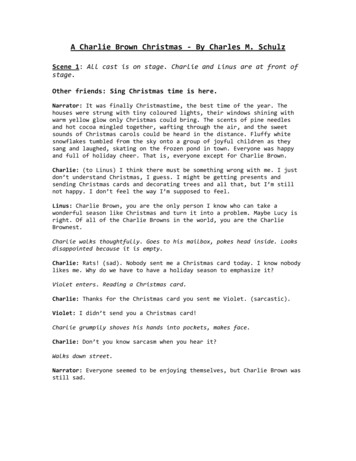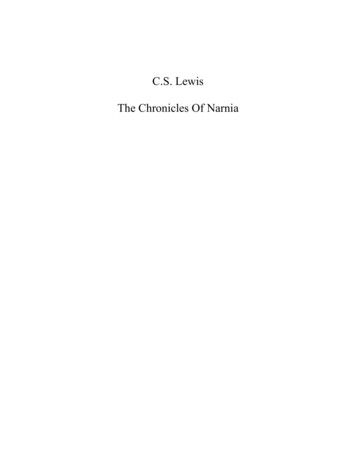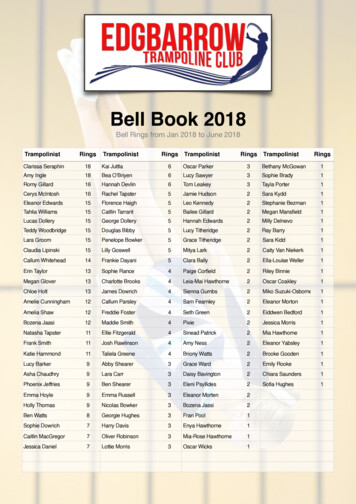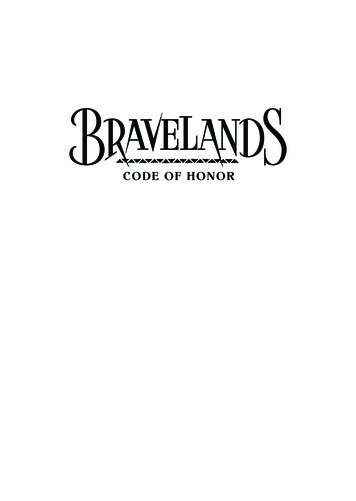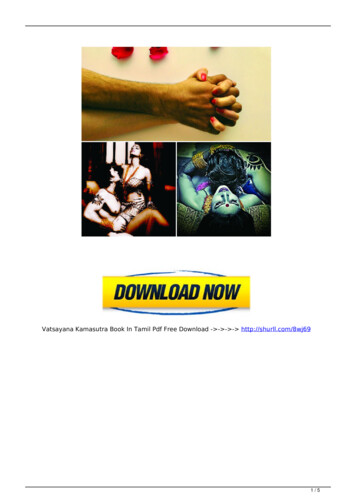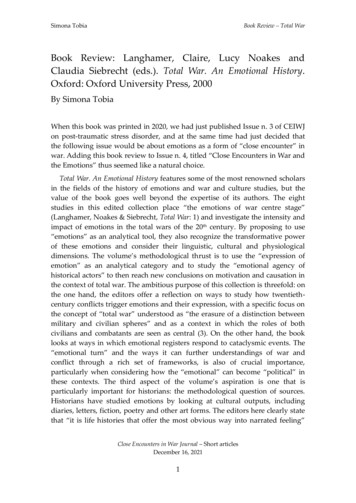
Transcription
Simona TobiaBook Review – Total WarBook Review: Langhamer, Claire, Lucy Noakes andClaudia Siebrecht (eds.). Total War. An Emotional History.Oxford: Oxford University Press, 2000By Simona TobiaWhen this book was printed in 2020, we had just published Issue n. 3 of CEIWJon post-traumatic stress disorder, and at the same time had just decided thatthe following issue would be about emotions as a form of “close encounter” inwar. Adding this book review to Issue n. 4, titled “Close Encounters in War andthe Emotions” thus seemed like a natural choice.Total War. An Emotional History features some of the most renowned scholarsin the fields of the history of emotions and war and culture studies, but thevalue of the book goes well beyond the expertise of its authors. The eightstudies in this edited collection place “the emotions of war centre stage”(Langhamer, Noakes & Siebrecht, Total War: 1) and investigate the intensity andimpact of emotions in the total wars of the 20th century. By proposing to use“emotions” as an analytical tool, they also recognize the transformative powerof these emotions and consider their linguistic, cultural and physiologicaldimensions. The volume’s methodological thrust is to use the “expression ofemotion” as an analytical category and to study the “emotional agency ofhistorical actors” to then reach new conclusions on motivation and causation inthe context of total war. The ambitious purpose of this collection is threefold: onthe one hand, the editors offer a reflection on ways to study how twentiethcentury conflicts trigger emotions and their expression, with a specific focus onthe concept of “total war” understood as “the erasure of a distinction betweenmilitary and civilian spheres” and as a context in which the roles of bothcivilians and combatants are seen as central (3). On the other hand, the booklooks at ways in which emotional registers respond to cataclysmic events. The“emotional turn” and the ways it can further understandings of war andconflict through a rich set of frameworks, is also of crucial importance,particularly when considering how the “emotional” can become “political” inthese contexts. The third aspect of the volume’s aspiration is one that isparticularly important for historians: the methodological question of sources.Historians have studied emotions by looking at cultural outputs, includingdiaries, letters, fiction, poetry and other art forms. The editors here clearly statethat “it is life histories that offer the most obvious way into narrated feeling”Close Encounters in War Journal – Short articlesDecember 16, 20211
Simona TobiaBook Review – Total War(20), as all chapters use a variety of forms of life-history materials, includingmemoirs and sources from the Mass Observation Project as well as thosementioned above. One notable omission in the problematization of sources isperhaps a reflection on the role of oral history as a form of life story, asmethodologically different from other forms of storytelling, for example for therole of intersubjectivity and memory composure, which set this type of sourcesapart from written ones.The relationship between emotion and power emerges as central in thecontexts of total war, as emotions are shaped by political power, but they canalso challenge the same powers. Emotions are also gendered and classed, as thevolume powerfully demonstrates.In the first chapter, historian Ute Frevert looks at emotional codes abouthonour and shame in the First World War, concluding that they are deeplygendered and never exclusively individual. As Joanna Bourke has observed(Bourke, The Emotions in War; Id., Fear and Anxiety), emotions are deeplyintertwined between culture, language and body, in a process in whichlinguistic and social interactions constitute those same sensations. Emotions arefeatured very strongly in wartime communicative lexicons, including – inFrevert’s work – notions of honour and shame, which were given new patrioticand political meanings. Male honour and national honour were seen assynonymous. However, both honour and shame had different meanings forwomen and men, for example, a shamed woman was a woman who had losther honour.Susan R. Grayzel authors the second chapter which looks at the emotionselicited by gas masks in France in the First World War. This object representedon the one hand the intention of the state to protect its citizens, and on the otherhand it was the concrete manifestation of fear, anxiety and terror elicited by thepossibility of the deployment of chemical weapons. In the interwar years, itssymbolic power was exploited both in the contexts of planning and resistance.Grayzel concludes that the emotions linked to this specific object could not beeasily controlled and that the gas mask shows the “fundamentalinterconnectedness” (Langhamer, Noakes & Siebrecht, Total War: 58) betweenobjects and the emotions in total war.Social and cultural historian Michael Roper looks at gender relations in thecontext of the caring provided to disabled soldiers by their daughters born afterthe conflict, in the same conflict as the two previous chapters. Roper concludesthat accounts of care were gendered because they differed between male andClose Encounters in War Journal – Short articlesDecember 16, 20212
Simona TobiaBook Review – Total Warfemale accounts: whereas men of the same generation tended to see care as aform of service to the nation, which carried ideas of pride and gratitude,women – daughters – saw this as a constraint on their aspirations. Care was atthe centre of cross-generational relationships which triggered deep emotions:“love was synonymous with obligation” (77). At the same time, however,women were also proud of assuming those responsibilities. For Roper, it wasthe failure of the state in providing care, coupled with the moral expectationsthrust upon these daughters, that informed the pressures to conform totraditional gender roles.Historian Claudia Siebrecht sees the tearful response of German women tothe invasion of Poland in 1939 as a legacy of the emotional responses to the FirstWorld War. Siebrecht studies accounts of crying and tearful responses in bothoral and written sources. This allows her to conclude that the outbreak of theSecond World War represented a crucial watershed in women’s biographies, astears are seen as the manifestation of the emotional response to war, and as alegacy to the emotions linked to the previous conflict.War historian Martin Francis examines, among other sources, the diary ofBritain’s Ambassador to Egypt, Sir Miles Lampson to study the juxtaposition ofdevastating public events such as total war with what he calls “banal domesticanxieties”, to conclude that public claims about the British war effort could bechallenged by private emotions. This research shows how even those who hadthe highest responsibilities in the conduct of the war struggled to manage theirprivate emotional responses, including “wounded pride and petty jealousies”.Francis insists on the importance of individual subjectivity for a more holisticunderstanding of the impact of total war.Historian Lucy Noakes analyses some life writing documents to look at theemotional lives of men in mid-twentieth century Britain, and at the ways inwhich experiences of combat in the Second World War shape their sense of self.Noakes argues that these sources are “sites where men attempted to fashion amilitarized masculinity” which often was communicated in a particularlyemotional style. Noakes also explains that through these forms of life writing,these authors construct forms of hybrid masculinity, which is subject toconstant renegotiation and expressed in a very emotional style.Claire Langhamer focuses on the Mass Observation Archive to examine theemotional responses of participants in the project. More specifically, Langhamerlooks at citizenship as an emotional practice and at how emotional responsescan become forms of political engagement. She argues that ways of expressingClose Encounters in War Journal – Short articlesDecember 16, 20213
Simona TobiaBook Review – Total Waremotions did not change significantly because of total war, however, the valueattached to lived experience did. Another argument that emerges from thisanalysis is that a new form of citizenship – emotional citizenship – emergedfrom the war years.The last chapter is also the only one that looks at a conflict other than the twoworld wars: the Greek Civil War. Here, historian Joy Damousi looks at familymaterials, including letters, photographs, interviews and even rumours, tocreate a historical archive of a specific experience: her uncle’s death in the GreekCivil War. This event shows that war can have a longer emotional legacy, andgrief can affect families long after wartime events, thus arguing how familyhistories can provide useful sources to study the complex interactions betweenemotions and war.The value of this edited collection is therefore manifold. By focusingspecifically on the history of emotions in total war, the volume goes beyond theemotions most widely associated with war, such as grief and fear, whichnonetheless are not overlooked. More importantly, the book offers a valuableoutlook of the methodological implications of the study of emotions in war andconflict. Personal sources such as letters, diaries, interviews, memoirs, andfamily history can allow the historian to focus on the subjective, and thisrepositions the role of the personal, the emotional, the subjective in the field ofhistory, to allow for a more overarching understanding of events and “themovement between the emotional intimacy of the small scale and the emotionalabstraction of the large scale.”War and culture studies and the history of war and conflict can certainlybenefit from this interest in intimate experiences, emotions and feelings, andexisting sources can be studied through the lens of the history of emotions. AsAlistair Thomson has shown (Thomson, Anzac Memories; Id., Indexing andInterpreting Emotion), oral history is one field that has embraced intimacy,subjectivity and emotions for a few decades and it is certainly one that cancontribute to the study of emotions in many ways.ReferencesBourke, Joanna. The Emotions in War: Fear and the British and American Military,1914-45. «Historical Research», 74, 185 (2001): 314-330.――――. Fear. A Cultural History. London: Virago, 2005.Close Encounters in War Journal – Short articlesDecember 16, 20214
Simona TobiaBook Review – Total War――――. Fear and Anxiety: Writing about Emotion in Modern History «HistoryWorkshop Journal», 55 (Spring 2003): 111-133.Costigliola, Frank. “Mixed Up” and “Contact”: Culture and the Emotions among theAllies in the Second World War. «International History Review», 20, 4 (1998),791-805.Langhamer, Claire, Lucy Noakes and Claudia Siebrecht (eds.). Total War. AnEmotional History. Oxford: Oxford University Press, 2020.Thomson, Alistair. Anzac Memories. Living with the Legend. Melbourne: MonashUniversity Publishing, 2013.――――. Indexing and Interpreting of Emotion: Joy and Shame in Oral History. InWords and Feelings: Reflecting on Oral History and Emotions, Special Issue of«Oral History Australia Journal», 41 (2019): 1-11.Close Encounters in War Journal – Short articlesDecember 16, 20215
War historian Martin Francis examines, among other sources, the diary of Britain’s Ambassador to Egypt, Sir Miles Lampson to study the juxtaposition of devastating public events such as total war with what he calls “banal domestic anxieties”, to conclude that public claims about the British war

